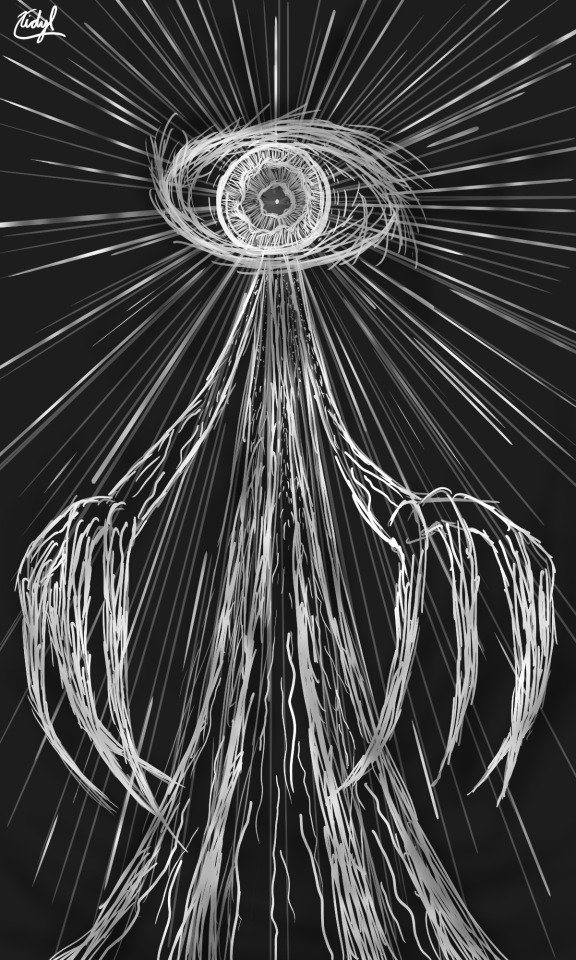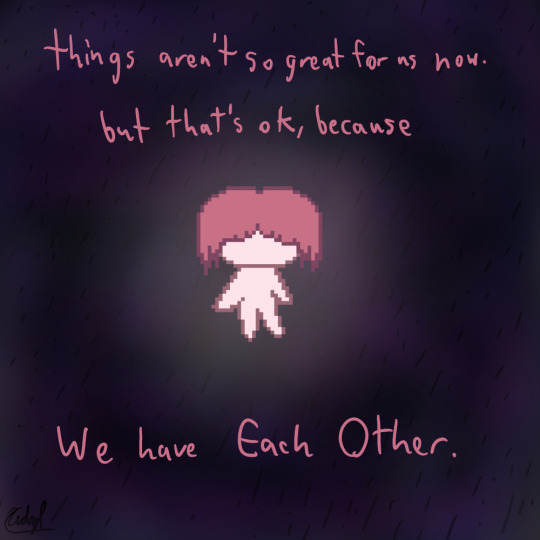(she/her) Hi this is my dedicated art blog, I'll be strictly posting my own art here. Main blog: @xlydrs
Don't wanna be here? Send us removal request.
Text

The Mind's Eye
A judgemental, twisted manifestation of one’s perception of themselves. The Mind’s Eye fools its host into believing that it is an objective observer, as it illuminates the most minute of flaws with brutal judgement, tearing into their psyche by fixating on their worst attributes, and making the host unable to see anything but the worst, most pitiful version of themselves. Its massive, swirling eye gazes high up, and demands constant attention while siphoning its host’s faith in themselves, putting a false spotlight on their internalized identity, all to make them fall into a paralyzed despair, to drain all of its host's willpower away.
The towering, fearsome appearance of the Mind’s Eye is actually an illusory projection, as the entity’s actual body is a very small sphere, no larger than an eyeball, which appears as the “pupil” of the illusory form in the center of the massive swirling eye.
5 notes
·
View notes
Text

Pixel art of Bibi! Wanted to play around a bit more with line art with this one
4 notes
·
View notes
Text

I drew Bibi like Marina's expression in the post below, mostly to use as a reaction with partners :3
She kinda looks like bingus in the way I drew her face lmao

^ post this was inspired from
6 notes
·
View notes
Text
Physiological evolution of Niyaki ancestors

1: the cradlefly, an ancient ancestor that has a body plan very similar to other 6 legged arthropods. It's namesake comes from their surprisingly complex parental behaviour, protecting mates as well as young with utmost devotion.
Forelimbs act as arms to hold food and groom other cradleflies, while midlimbs and backlimbs are focused on keeping the fly balanced and secure on the surface it stands on. Their diet mainly consists of smaller invertebrates, pollen, and fruits.
2. The prancefly, named after its curious movement pattern of "prancing" in a whimsical manner using its backlimbs and midlimbs. Forelimbs now are dedicated to holding onto food and prey, taking on a pursuit hunting lifestyle.
3. The branchhopper, with further specialization in its limbs to have a "hopping" lifestyle, springing forwards with its powerful back legs and fluttering its wings to quickly leap from branch to branch. Grows to the size of a frog, and has a pollenating/pursuit hunting lifestyle.
4. The grassflutterer, growing larger and taking on a ground walking lifestyle, its back legs have pivoted towards a digitigrade-like orientation, making its body plan converge similarly to digitigrade vertebrates. Now as large as a dog, these arthropods stride the plains, using their midlimbs to dig into the ground for roots and invertebrates, and pick fruits from trees. It is named after its defense mechanism from pursuing predators, leaping into the air and fluttering its wings to stay airbourne for a short while.
5. The crioblix, a more obvious ancestor to both queblix and niyaki. Its backlimbs and forelimbs have bulked up in size to carry the creature's weight, growing to the size of an ape. Its diet mainly consists of fruits, nuts, roots, and prey that they occasionally hunt.
It still walks on four limbs, though its back legs have grown strong enough for it to be able to stand on its back legs, used for reaching fruits, intimidation, or for complex social interactions, in which groups of crioblix stand up on their back limbs for as long as possible and flash and flutter their wings, often decorated with intricate patterns. This behaviour is known as the standing dance, which is theorized to help naturally select for crioblix with particularly powerful and stable legs.
6A: the modern queblix, a pack hunting close cousin of the Niyaki, with complex social groups, hunting strategies, and developing their own language. Diverged from the Niyaki body plan, taking on a quadrupedal form with powerful limbs and adapting its small limbs into small hands.
6B: the niyaki body plan, taking on an upright position and using its back legs to hold the entire weight of its body. Forelimbs became fully developed arms and hands, and they use both their forelimbs and midlimbs to hold onto and manipulate objects.
10 notes
·
View notes
Text
Page of Beanface. What having no internet for a few hours does to a MF

4 notes
·
View notes
Text
Some Bibi sketches when I first designed her :3

My first sketch of her design

Bibi face practice

Assorted sketches, shows her facial opening when it opens/closes

Creature to creature communication

Bonus: Bibi making a face based on this strange organism

6 notes
·
View notes
Text

Finally drew my new persona! Her name is now Bibi! I'm trying out a new, slightly sketchy style with the line work and I am really liking it.
Not exactly a different person from Argeebi, Bibi is still the same individual as Argeebi, she just grew up a bit :3 And got quite a significant glow up!
Her "crop top hoodie" grew out into a long dress, and her long ears got a bit shorter and flappier, now appearing very similar to a dumbo octopus's fins. She also grew 4 antennae, though they don't actually have any sensory purpose, and are just there to look cute, as well as express emotions through their positioning. Her face opening, or "hood" now has 5 flaps that make her face appear star shaped. Those flaps can contract and tighten to completely conceal her face, which she does whenever she is overstimulated, cold, anxious, or asleep.
10 notes
·
View notes
Text
I'm going to draw again
Sometimes you just gotta say "my art is good" and keep going
11 notes
·
View notes
Text
Sometimes you just gotta say "my art is good" and keep going
11 notes
·
View notes
Text
Screelch mandible sketches

Wanted to try fleshing out some screelch anatomy since it's been a while since I drew one.
The screelch, much like the grunids, are 4 mandibled vertebrates. Unlike the grunids, however, screelches have their mandibles outside of their mouth rather than concealed inside. This gives their heads an incredibly striking and unique appearance, with their often intimidating mandibles in clear display.
Screelches lack teeth or a tongue, meaning they almost entirely rely on their mandibles for moving food into their mouth and breaking it apart, in an "external chewing" fashion. Species with smaller mandible lengths tend to rely on crushing their food with their beaks instead, feeding on nuts, seeds, and bone marrow.
Their mandibles are reinforced with bone and covered in keratin, giving it an appearance incredibly similar to invertebrate mandibles.
Screelch mandibles vary wildly in length and purposes. Some are short and only serve the purpose of grasping onto nuts and fruits, others are thin and spindly to poke into insect burrows, and others are viscous and spiked to tear into prey.
Many screelches have had their forelimbs become vestigial to make their body more aerodynamic, making their mandibles essentially act like limbs. Some have even been able to use their mandibles to operate tools and humanoid machinery.
7 notes
·
View notes
Text

A common forest nylx, relaxing and taking in the sunlight. Land nylxates do not always grow as large as their aquatic cousins, and this individual is of medium size, about as tall as a domestic cat.
Most land nylxes are omnivores and have niches similar to tegus or possums, as many are too slow to actively chase prey. Their diet mostly consists of invertebrates, fruit, decaying tree flesh, and worms.
They can be found worldwide with a wide variety of niches. This land nylx has a humble lifestyle of wandering the forest floor and digging for small invertebrates to feed on, using its electroreceptive antennae on its snout to detect wriggling movement.
They are rather docile and friendly to creatures who are clearly not natural predators, and have a wide diet, making them ideal domestic pets. Their tendril antennae are sensitive to motion and many actually feel excited when their tedril antennae are touched softly, and a land nylx allowing you to pet and touch their tendrils is a sign of trust and close affection.
11 notes
·
View notes
Text
Feather Duster Worm sketch

6 notes
·
View notes
Text
Magnapinna Squid sketch

18 notes
·
View notes
Text

some dumbo octopi :> I drew this for the world but also for myself. Im happi with it
22 notes
·
View notes
Text

vent art but..... im just glad i did manage to draw something
19 notes
·
View notes
